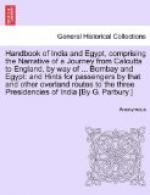and close-fitting white garments; Cutchi sea-farers,
descendants of the pirates of dead centuries, with
clear-cut bronzed features that show a lingering strain
of Med or Jat, clad in white turbans, tight jackets,
and waist cloths girded tightly over trousers that
button at the ankle. There, mark you, are many
Bombay Mahomedans of the lower class with their long
white shirts, white trousers and skull-caps of silk
or brocade: there too is every type of European
from the almost albino Finn to the swarthy Italian,—sailors
most of them, accompanied by a few Bombay roughs as
land-pilots; petty officers of merchant ships, in
black or blue dress, making up a small private cargo
of Indian goods with the help of a Native broker;
English sailors of the Royal Navy; English soldiers
in khaki; Arabs from Syria and the valley of the Euphrates;
half-Arab, half-Persian traders from the Gulf, in Arab
or old Persian costumes and black turbans with a red
border. Here again comes a Persian of the old
school with arched embroidered turban of white silk,
white “aba” or undercoat reaching to the
ankles, open grey “shaya,” and soft yellow
leather shoes; and he is followed by Persians of the
modern school in small stiff black hats, dark coats
drawn in at the waist, and English trousers and boots.
After them come tall Afghans, their hair well-oiled,
in the baggiest of trousers; Makranis dressed like
Afghans but distinguished by their sharper nose and
more closely-set eyes; Sindis in many-buttoned waistcoats;
Negroes from Africa clad in striped waist cloths, creeping
slowly through the streets and pausing in wonder at
every new sight; Negroes in the Bombay Mahomedan dress
and red fez; Chinese with pig-tails: Japanese
in the latest European attire; Malays in English jackets
and loose turbans; Bukharans in tall sheep skin caps
and woollen gabardines, begging their way from Mecca
to to their Central Asian homes, singing hymns in
honour of the Prophet, or showing plans of the Ka’aba
or of the shrine of the saint of saints, Maulana Abdul
Kadir Gilani, at Baghdad.
[Illustration: A Millhand.]
[Illustration: A Marwari selling Batassa.]
The ebb and flow of life remains much the same from
day to day. The earliest street sound, before
the dawn breaks, is the rattle of the trams, the meat-carts
on their way to the markets, the dust-carts and the
watering-carts; and then, just as the grey thread of
the dawn fringes the horizon, the hymn of the Fakir
rings forth, praising the open-handed Ali and imploring
the charity of the early-riser who knows full well
that a copper bestowed unseen during the morning watch
is worth far more than silver bestowed in the sight
of men. On a sudden while the penurious widows
and broken respectables are yet prosecuting their rounds
of begging, the great cry “Allaho Akbar”
breaks from the mosques and the Faithful troop forth
from their homes to prayer—prayer which
is better than sleep. More commonplace sounds
now fill the air, the hoarse “Batasaa, Batasaa”




